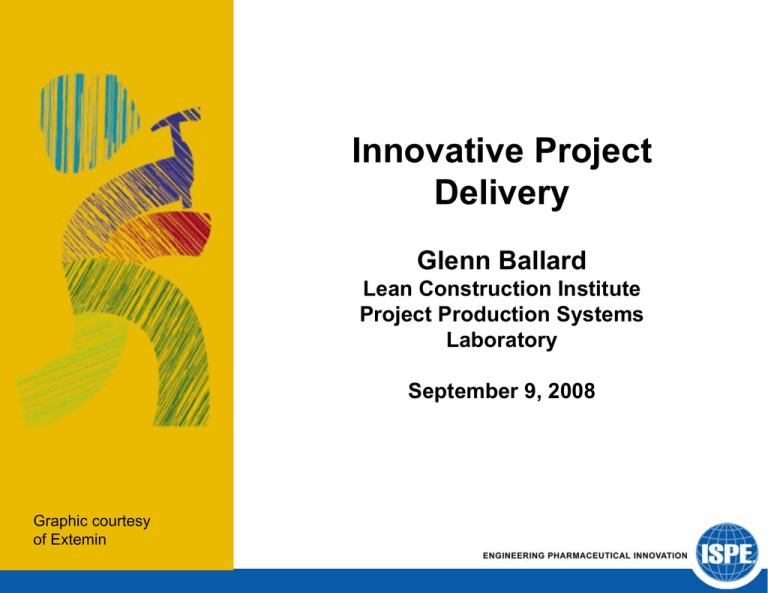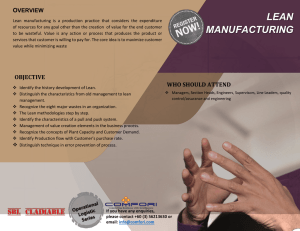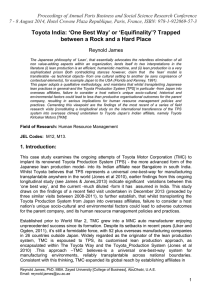Innovative Project Delivery Glenn Ballard Lean Construction Institute
advertisement

Innovative Project Delivery Glenn Ballard Lean Construction Institute Project Production Systems Laboratory September 9, 2008 Graphic courtesy of Extemin Focus on Process and Risk • Design and construction of buildings and infrastructure is a risky activity • Buildings have become ever more complex over time, engendering greater and greater risks in design, construction, and operations • Distinguish Insured Risk vs Managed Risk • While insurance is an important subject, the big opportunity lies in how we manage risk throughout the design and construction process The Big Idea • What if every member of the team shared completely the responsibility for the entire project and set about correcting deficiencies or problems wherever they popped up without regard to who caused the problem or who is going to pay for it? • What if all team members were friends looking out for the interest of the Client and each other, applauding the successes of each other and sharing the pain of each others failures? • What if all of the design and construction entities on a project could be organized in such a way that they all functioned as if they truly were a single company with a single goal and with no competition amongst themselves for profit or recognition? Greg Howell Glenn Ballard Lean Construction Institute Traditional Project Delivery • Traditional Contracting limits cooperation and innovation. • Inability to fully coordinate the project. • Good ideas are held back. Owner A/E Team Lawyers Builder Tools and Techniques • New tools for design and coordination, and new techniques of construction management, production planning, and scheduling have made possible a new approach to organizing the project delivery process • These tools include: – Building Information Modeling (BIM) for design and coordination – Lean Construction Management for improved production planning and control – Team structure for collaboration in project execution – Integrated Project Delivery Integrated Project Delivery • A single contract binds the IPD team. • Team shares risk and profit for total project performance. • Interests of all team members are aligned for optimal project performance. • Team members bring forward best ideas. • Effective solutions can be devised with shared responsibility for overall costs. Incentivized Design-Build Owner At the core of an integrated project are collaborative, integrated and productive teams composed of key project participants. Building upon early contributions of individual expertise, these teams are guided by principles of trust, transparent processes, effective collaboration, open information sharing, team success tied to project success, shared risk and reward, value-based decision making, and utilization of full technological capabilities and support. The outcome is the opportunity to design, build, and operate as efficiently as possible. - Quoted from the AIA IPD Guide A/E Team Builder Value Stream Mapping: Detailing of Reinforced Concrete Structures Rebar Production Process & CONWIP Control Pull Engineering Fabrication & Assembly 2 Days 1 Days ProjectFlow Installation 2 Days Results: •First major UK civil project in last 40 years to be delivered on time •$125 million cost savings in civils phase; 10% of contract value Toyota Production System (aka Lean) •Started in the 1950’s •Chief Architects – Taichi Ohno & Shigeo Shingo •Challenge: – Limited Cash & Space – Sophisticated Customers •Goal: – A custom product, delivered instantly, with nothing in stores. Source: The Machine that Changed the World by Womack, Jones & Roos Courtesy of Strategic Project Solutions Inc. 2005 Waste Consumes Resources without Providing Value 1. Overproduction 4. Movement 3. Inventory 2. Waiting 5. Effort 6. Rework of Errors 7. Processing The Toyota Way • Toyota Production System • Toyota Product Development System Respect for People Continuous Improvement Key Features of Lean in Project Production Systems • The larger system is the focus of management attention, not local optimization • Activities are performed at the last responsible moment • Stakeholder interests are aligned through relational contracts • The rule followed for release of work between connected specialists is: Flow where you can, Pull where you can’t, Push where you must • Downstream players are involved in upstream work, and vice-versa • Product and process are designed together; indeed, all design criteria are considered when generating and selecting from design options • All product life cycle stages are considered in design • Standards are the starting point for improving how work is done • Variation is attacked and reduced — variation in work load, in process durations, in product quality, in plan reliability, … • Inventory, capacity, schedule and financial buffers are sized and located to perform their function of absorbing variability that cannot yet be eliminated • Necessity, the mother of invention, is self-imposed to cause innovation and learning Piping from Detailed Engineering through Installation 90% 80% 70% 60% 50% 40% 30% 20% 10% 0% Weeks 55 50 45 40 35 30 25 20 15 10 5 % Planned ISOs Release % Aactual ISOs Release % Planned Fabrication % Actual Fabrication % Planned Installation % Actual Installation Wk % of Total 100% 100 90 70 of All Pipe is Installed % Pipe on Hand When 20% 80 60 50 40 30 20 10 0 0.5 Under 1 Over Performance Against Budget 1.5 Key Features of Lean in Project Production Systems • The larger system is the focus of management attention, not local optimization • Activities are performed at the last responsible moment • Stakeholder interests are aligned through relational contracts • The rule followed for release of work between connected specialists is: Flow where you can, Pull where you can’t, Push where you must • Downstream players are involved in upstream work, and vice-versa • Product and process are designed together; indeed, all design criteria are considered when generating and selecting from design options • All product life cycle stages are considered in design • Standards are the starting point for improving how work is done • Variation is attacked and reduced — variation in work load, in process durations, in product quality, in plan reliability, … • Inventory, capacity, schedule and financial buffers are sized and located to perform their function of absorbing variability that cannot yet be eliminated • Necessity, the mother of invention, is self-imposed to cause innovation and learning Chief Engineer Suzuki’s YETs YET • Great high-speed handling/stability • Fast and smooth ride • Super quiet • Elegant styling • Warm • Great stability at high speed From Jeffrey Liker’s The Toyota Way • A pleasant ride • • • • • Low fuel consumption Light weight Great aerodynamics Functional interior Low aerodynamic friction Shawano Clinic • The target cost (construction budget) was set 3.6% below the benchmark, the target cost was underrun by 8.4%, and the benchmark was underrun by 11.7%. • $717,696 in valued scope was added. • •The project was completed 3.5 months ahead of schedule –70 additional days of clinic revenue translating into nearly $1 million in the expanded imaging service line functions and additional revenue in the 2006 year. Reducing needed buffers to spur innovation • • • • • Remove traditional design solutions (inventory-information) Set a target cost below allowable cost (money) Shrink target durations (time) Reduce laydown space (inventory-material) Set a target productivity better than current best practice (capacity) Key Features of Lean in Project Production Systems • The larger system is the focus of management attention, not local optimization • Activities are performed at the last responsible moment • Stakeholder interests are aligned through relational contracts • The rule followed for release of work between connected specialists is: Flow where you can, Pull where you can’t, Push where you must • Downstream players are involved in upstream work, and vice-versa • Product and process are designed together; indeed, all design criteria are considered when generating and selecting from design options • All product life cycle stages are considered in design • Standards are the starting point for improving how work is done • Variation is attacked and reduced — variation in work load, in process durations, in product quality, in plan reliability, … • Inventory, capacity, schedule and financial buffers are sized and located to perform their function of absorbing variability that cannot yet be eliminated • Necessity, the mother of invention, is self-imposed to cause innovation and learning Thank you for your attention






